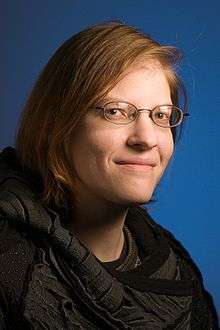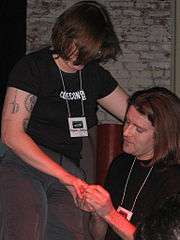Meredith L. Patterson
| Meredith L. Patterson | |
|---|---|
 Meredith Patterson (2010) | |
| Born | April 30, 1977 |
| Residence | Brussels |
| Occupation | Researcher, writer |
| Known for | DIYbio, X.509 attacks |
| Spouse(s) | Len Sassaman (2006–2011; his death) |
| Website |
www |
Meredith L. Patterson (born April 30, 1977[1]) is an American technologist, science fiction writer, and journalist. She has spoken at numerous industry conferences on a wide range of topics.[2] She is also a blogger and software developer, and a leading figure[3] in the biopunk movement.
Early life
Patterson spent her first 24 years living in and around Houston, before moving to Iowa City, Iowa, to pursue her Master's degree in Linguistics and PhD in Computer Science.[4] Patterson attended Kingwood High School from 1990 to 1994.[5] She supported herself doing odd-jobs from website designer, technical writer, math teacher and professional restaurant critic to reporter for the Houston Press,[6] She served as the Treasurer of the Mars Society Houston branch[7] in 1999. That same year, at age 22, she traveled above the Arctic Circle as a NASA correspondent for a Mars simulation mission.[8]
Computer science and academic career
Patterson is known for her work in computational linguistics and its applications to computer security. In 2005, she presented the first parse tree validation technique for stopping SQL injection attacks at the Black Hat conference in Las Vegas.[9]
She has integrated her support vector machine datamining library inside of PostgreSQL to provide a "query-by-example" extension to the SQL language, allowing DBAs to quickly and easily form complex datamining requests based on example positive and negative inputs. While this work was initially funded by Google's Summer of Code program,[10] Patterson's datamining work now forms the basis of her startup, Osogato, which couples the datamining database with acoustic feature extractors allowing users to create playlists from their own music collections and find new music based on the inherent properties of the music they provide as sample inputs. Osogato was launched at SuperHappyDevHouse.[11]
Prior to founding Osogato, Patterson worked for Mu Security (now Mu Dynamics). Before that, she was a PhD student at the University of Iowa. She did her undergrad in linguistics at the University of Houston and received her Masters in linguistics from the University of Iowa.[12]
Patterson has contributed to multiple open-source database software projects, including SciTools,[13] Klein,[14] QBE,[15] and written patches to PostgreSQL.[16] Her "Dejector" library integrates with PostgreSQL to implement the SQL injection approach taken in her Black Hat paper.[17] Patterson is also credited with contributing to the Summer of Code project Firekeeper,[18] which her husband mentored.
In 2009 at BlackHat, Dan Kaminsky presented joint work with Patterson and Sassaman, revealing pervasive flaws in the Internet's certificate authority infrastructure. Their work revealed that existing web browsers could be fooled into accepting fraudulent X.509 certificates.[19][20]
Writing career
As a science fiction author, Patterson has published numerous short stories in such magazines as Fortean Bureau and Strange Horizons and in compilations such as The Doom of Camelot and The Children of Cthulhu, and is credited with contributing to the Steve Jackson Games game GURPS Villains. Her poetry has been influenced by her scientific research; for example, her poem "Leaving Devon Island"[21] is in reference to the Flashline Mars Arctic Research Station on Devon Island, Nunavut, Canada.
Blogger
Patterson frequently discusses such issues as copyright reform,[22] biohacking,[23] the Military Commissions Act,[24] Proposition 8 and civil rights issues,[25] and programming languages[26] on her personal blog. Patterson has also contributed multiple articles to the popular blog BoingBoing.[27][28][29][30]
In spring of 2008, she published a paper with David Chaum and Len Sassaman[31] in a USENIX workshop[32] criticizing the lack of attention paid to user-privacy in the OLPC (One Laptop per Child) computer.[33]
Biohacker
In addition to her professional work[34] as a bioinformaticist for Integrated DNA Technologies, Patterson is a key figure in the biohacker movement,[35] with H+ Magazine referring to her as the doyenne d'DIYBIO.[36] She has collaborated with her husband to design glow-in-the-dark yogurt using GFP plasmids, and is also working on other synthetic biology projects, such as creating a low-cost melamine contamination field test, and a strain of yogurt bacteria that completes the metabolic pathway for vitamin C, to prevent scurvy.[37] She is a regular contributor to the DIYbio group discussions and a user of the OpenWetWare wiki.
Personal

A two-time CodeCon presenter, Patterson married the co-organizer of the event, Len Sassaman, after a public proposal at CodeCon 2006. As Sassaman was famous among the geek community in his own right, their marriage was held up as an example of a geek power couple.[38]
Patterson, who was diagnosed with autism in adulthood, has stated that "a single-minded focus" has helped her to have an "overwhelmingly positive relationship" with the male-dominated technology community.[39] Although acknowledging that other women have experienced discrimination or sexual assault, she has urged advocacy groups not to minimize the experiences of women who feel welcome, and prefers the Anita Borg Institute for Women and Technology over the Ada Initiative on these grounds.[40]
See also
References
- ↑ "Radio Free Meredith". Maradydd.livejournal.com. Retrieved January 4, 2012.
- ↑ Presentations
- ↑ "h+ Magazine Summer 2009 Issue". Hplusmagazine.com. Retrieved January 4, 2012.
- ↑ "Meredith L. Patterson, M.A., M.S.". Lifeboat Foundation. Retrieved 2015-11-09.
- ↑ Belgium. "Radio Free Meredith". Maradydd.livejournal.com. Retrieved January 4, 2012.
- ↑ Patterson, Meredith (1998-01-15). "Made In Houston". Houston Press. Retrieved 2015-11-09.
- ↑ "The Mars Society of Houston". Marshouston.org. Retrieved January 4, 2012.
- ↑ Bio printed along with a story in the Fortean Bureau
- ↑ "Stopping SQL Injection Attacks" (PDF). Retrieved January 4, 2012.
- ↑ "O'Reilly Emerging Technology Conference presentation". Conferences.oreillynet.com. Retrieved January 4, 2012.
- ↑ "SHDH presentation". Superhappydevhouse.org. October 22, 2011. Retrieved January 4, 2012.
- ↑ "Personal bio". Thesmartpolitenerd.com. Retrieved January 4, 2012.
- ↑ SciTools Presentation
- ↑ "Klein". Sourceforge.net. Retrieved January 4, 2012.
- ↑ "QBE". Pgfoundry.org. Retrieved January 4, 2012.
- ↑ PostgreSQL Summit
- ↑ "Dejector". Thesmartpolitenerd.com. Retrieved January 4, 2012.
- ↑ Firekeeper. "Firekeeper". Firekeeper.mozdev.org. Retrieved January 4, 2012.
- ↑ Rodney (August 2, 2009). "Dan Kaminsky Feels a disturbance in The Internet". Semiaccurate.com. Retrieved January 4, 2012.
- ↑ Goodin, Dan (July 30, 2009). "Wildcard certificate spoofs web authentication". Theregister.co.uk. Retrieved January 4, 2012.
- ↑ "Leaving Devon Island". Thesmartpolitenerd.com. February 22, 1999. Retrieved January 4, 2012.
- ↑ "Orphan Works Misconceptions". Opencongress.org. April 27, 2008. Retrieved January 4, 2012.
- ↑ "DNA Purification". Maradydd.livejournal.com. December 16, 2003. Retrieved January 4, 2012.
- ↑ "A Layman's Guide to Dealing with the Military Commissions Act of 2006". Retrieved January 4, 2012.
- ↑ "Radio Free Meredith – Prop 8 postmortem, Part 2: Dissecting the Present". Maradydd.livejournal.com. November 5, 2008. Retrieved January 4, 2012.
- ↑ "Programming language analogies". Maradydd.livejournal.com. February 28, 2006. Retrieved January 4, 2012.
- ↑ Doctorow, Cory. "Crowdsourced Science". BoingBoing. Retrieved January 4, 2012.
- ↑ Doctorow, Cory. "Countering the FUD". BoingBoing. Retrieved January 4, 2012.
- ↑ Doctorow, Cory. "iPhone repair company iResQ". BoingBoing. Retrieved January 4, 2012.
- ↑ Doctorow, Cory (March 29, 2005). "Songs as BASIC Programs". BoingBoing. Retrieved January 4, 2012.
- ↑ "Freezing More than Bits" (PDF). Retrieved January 4, 2012.
- ↑ "UPSEC". Usenix.org. Retrieved January 4, 2012.
- ↑ "Laptops could Betray Users in the Developing World". Technology.newscientist.com. June 5, 2008. Retrieved January 4, 2012.
- ↑ "Identification of Motifs that Significantly Associate with Antisense Sequence Activity" (PDF). Retrieved January 4, 2012.
- ↑ Wohlsen, Marcus (2008-12-26). "Hobbyists are trying genetic engineering at home". Seattle Times. Retrieved 2015-11-09.
- ↑ "Darning Genes: Biology for the Homebody". Hplusmagazine.com. Retrieved January 4, 2012.
- ↑ "Rise of the Garage Genome Hackers". New Scientist. January 7, 2009. Retrieved January 4, 2012.
- ↑ "CodeCon Valentines". Geekentertainment.tv. February 20, 2006. Retrieved January 4, 2012.
- ↑ Patterson, Meredith (2013-10-14). "Okay Feminism, It's Time We Had a Talk About Empathy". Medium. Retrieved 2015-11-09.
- ↑ Patterson, Meredith (2012-10-17). "Advocacy group preference". Twitter. Retrieved 2015-11-09.
External links
| Wikimedia Commons has media related to Meredith L. Patterson. |